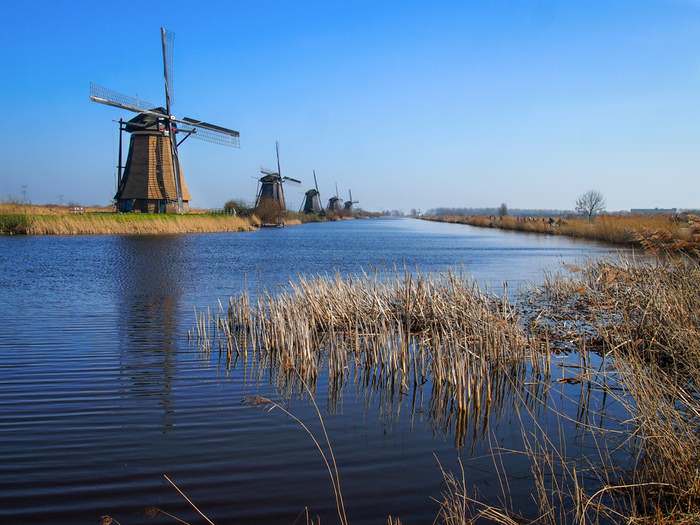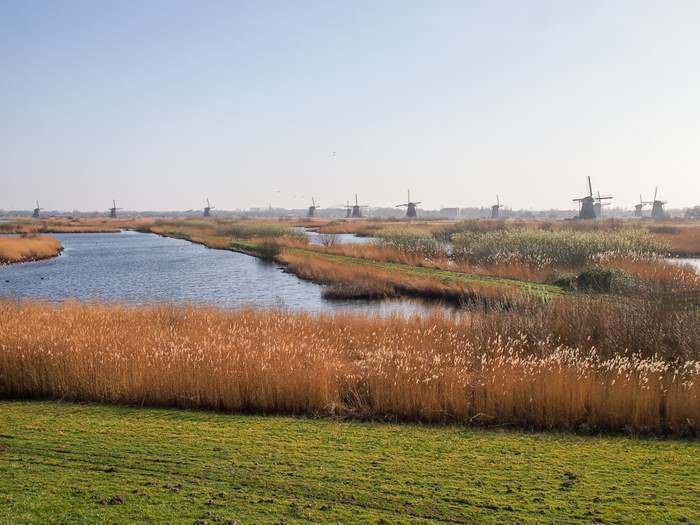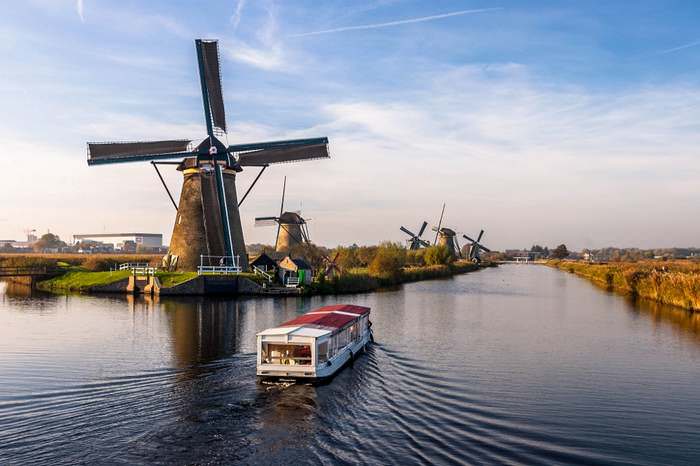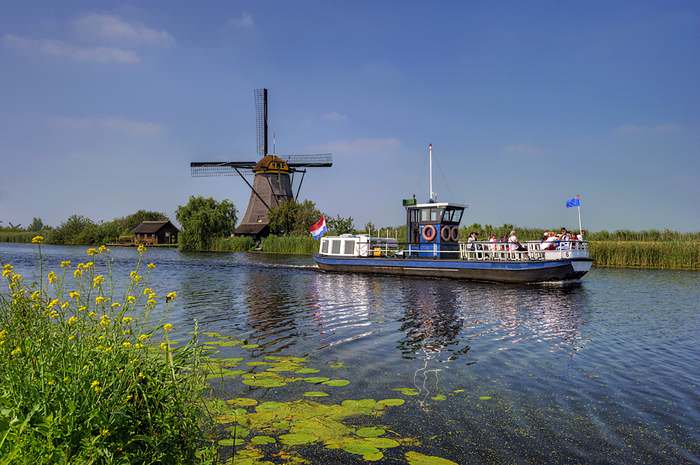If you’re looking for the quintessential Dutch landscape, you can’t find a better one than Kinderdijk. Located a mere sixteen kilometers from Rotterdam , in the province of South Holland, this tiny village is home to the Kinderdijk Windmills. These nineteen old windmills, make up the most dense concentration of windmills in the entire Netherlands. It lies at the confluence of two meandering rivers—the Lek and Noord Rivers—in the Alblasserwaard polder. With about a quarter of its territory situated below sea level, the Netherlands couldn’t be more appropriately named. And, because of this, the country is very prone to flooding.

Windmills in Kinderdijk line the Overwaard canal
The Dutch—innovative as they are—devised systems to protect themselves from flooding as early as the 13th century. The world-renowned canals were, of course, one of them. Windmills were another one. In the Netherlands, windmills weren’t solely for processing grain; they were also used as water pumps. At one point, there were no fewer than 10,000 windmills in the country.

A quintessential Dutch landscape
Nowadays, the windmills in Kinderdijk are arguably the most famous collection of water-pumping windmills left in the Netherlands—a major tourist attraction that consists of a network of reed-lined canals, expansive meadows, peaceful bicycle routes, locks, pumping stations, and nineteen historic windmills. It’s the only place in the world where this large a number of windmills can be seen (and visited) in such a small area. The cultural and historic importance of the Kinderdijk windmills was recognized by UNESCO in 1997, when the area was declared a World Heritage Site.
The Kinderdijk Windmills are a Year-round Attraction
Kinderdijk is a marvelous destination throughout the entire year. The World Heritage Site is opened to the public every season of the year, but you should check the official website for maintenance and/or closing times, just in case. While the windmills themselves might not always be opened—many of them serve as actual houses and aren’t open to the public as it is—you can always walk and bicycle along them. The walking and bicycling path is constantly accessible and is always free.

A beautiful fall day in Kinderdijk _Flickr by 45804417@N00
Entry to the World Heritage Site Kinderdijk includes access to the museum windmills, Blokweer and Nederwaard, (which are still operated by an actual professional miller). The Wisboom Pumping Station (which is also the visitor center) provides tourists with great views of tourist vessels that travel the Overwaard canal.
Kinderdijk is arguably at its most stunning in mid-winter after a night of frost. Then, the landscape is covered in a thin sheet of ice, a white blanket that carpets the scenery in the most breathtaking way and creates a scene that could come straight out of a Breughel painting. On a crisp blue-skied winter day, a bike ride or walk along the windmills is enchanting and spectacular.

Ice skating on the canals – from Flickr by Arthur
When nature comes back to life in spring, the Kinderdijk windmills are surrounded by colorful wildflowers, and warmer weather which makes it a wonderful place to visit over a weekend. In summer, the busiest time of the year, you can expect large crowds, but also gorgeous weather.

Wildflowers surround the windmills in spring – Flickr by Aidan Morgan
Fall has its very own atmosphere. The thick reeds that line the canals turn brown; and the few trees that dot the polder landscape lose their leaves. Nothing is as beautiful as a chilly October morning to go for a refreshing walk along the world’s most famous windmills.
While each season has its particular advantages and perks, winter is possibly the most charming time of year to visit Kinderdijk—that is, of course, entirely subjective, but I’m quite sure that the beauty of a white, frosty, wintry landscape in Kinderdijk can’t be matched by the flowers of spring, the greens of summer and the browns of fall.

A tourist boat travels past the Kinderdijk windmills – Flickr by Alex Hanoko
Because Kinderdijk is such a popular destination in the Netherlands, it is conveniently reached from the country’s major cities. Rotterdam, the Netherlands’ second-largest city, lies only sixteen kilometers away and public transportation—the bus—between the two places is excellent. Rotterdam itself is easily reached by train from Amsterdam, Utrecht or other large cities in the country. There are also private companies that organize visits to Kinderdijk by bus from Amsterdam. People who are staying in Rotterdam or nearby Dordrecht, which incidentally is the oldest town in the Netherlands and makes for a nice destination as well. You can also get to the Kinderdijk windmills by waterbus via the rivers—this is definitely the most scenic option.
Written by Bram Reusen for EuropeUpClose.com

KareninCalabria
Tuesday 2nd of February 2016
Beautiful photos - I love the contrast of the windmills in the snow with the wildflower scene just below it!